TechRadar Verdict
The Nvidia GeForce RTX 3070 Ti delivers some excellent 1440p performance and looks good while doing it. The problem is, though, that every other graphics card can do that right now, meaning there's little reason to pick the RTX 3070 Ti over another GPU.
Pros
- +
Excellent performance
- +
Good cooler
- +
Nice design
- +
Included adapter
Cons
- -
Performance doesn't justify price
- -
More power-hungry than 3070
- -
You need an adapter
- -
No USB-C
Why you can trust TechRadar
The Nvidia GeForce RTX 3070 has been out for about eight months now, so it shouldn't be too much of a surprise that the Nvidia GeForce RTX 3070 Ti is here. That's typically the time frame we see for mid-generation refreshes, but in the world of the best graphics cards we're far from "typical times". Right now, it's incredibly difficult to buy a new graphics card, let alone the RTX 3070, which is by and large the best GPU for most people.
So, you would think a refreshed version of that graphics card would make sense – but the pricing is completely wrong. Starting at $599 (£529, AU$959) – with prices for aftermarket versions likely getting exponentially higher – the Nvidia GeForce RTX 3070 Ti is a full 20% more expensive than the RTX 3070, and you're not even getting that much more performance out of it. In most games, the RTX 3070 Ti is just 5-10% faster, according to our tests, and is absolutely not worth the difference in price. Once the market comes back to normal, there will be no reason to ever buy this card.
But, right now the market is anything but normal, and our advice is still basically "buy any graphics card you can find at or near MSRP". And at the end of the day, if the RTX 3070 Ti is the graphics card you can find, it still delivers an excellent 1440p gaming experience, and can even stretch its legs into 4K given the opportunity – though this shouldn't be your first choice of a 4K graphics card.
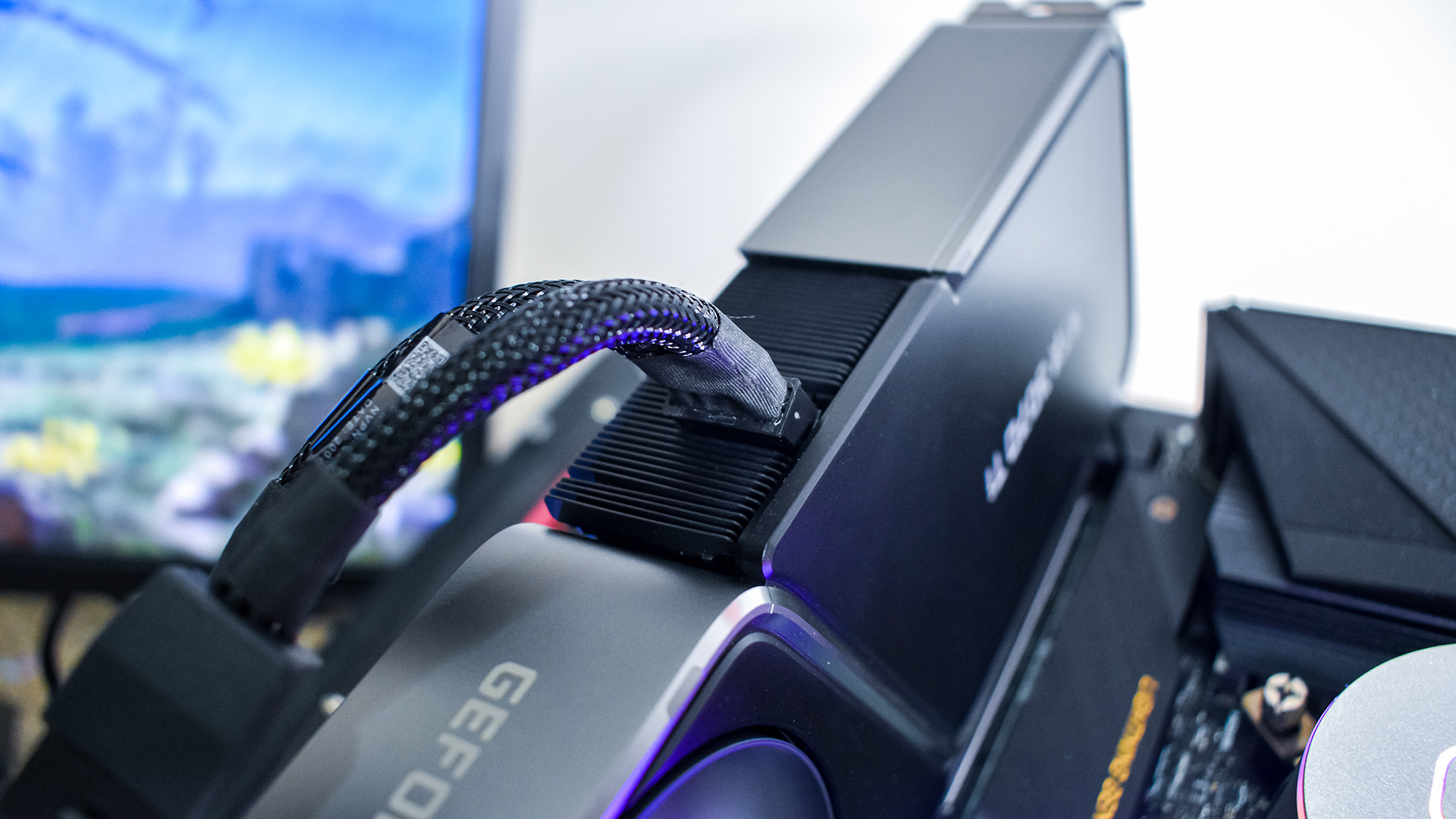
Price and availability
The Nvidia GeForce RTX 3070 Ti is available June 10, starting at $599 (£529, AU$959). That makes it quite a bit more expensive than the original RTX 3070 at $499 (£469, AU$809), with the same difference between it and the $699 (£649, about AU$950) RTX 3080. However, while the RTX 3070 Ti sits right in the middle of the two Ampere heavyweights in price, it's much closer to the RTX 3070 in performance than the RTX 3080.
That puts the Nvidia GeForce RTX 3070 Ti in a really awkward position, especially once the graphics card market returns to any semblance of normality. Because, as we'll explore further later on, this graphics card does not separate itself enough from the RTX 3070 to actually be worth the extra cash.
And, even if you do have the budget to get something more expensive than the Nvidia GeForce RTX 3070, you shouldn't be going for the RTX 3070 Ti, because the RTX 3080 is going to be a much more impactful difference. Where the RTX 3070 is a champion of providing excellent value for the money, the RTX 3070 Ti completely goes against that card's legacy and feels more like a cash grab - it really should be sitting at around $549, with how much of an improvement it actually brings to the table.
But the fact remains that if you're on the market for a graphics card, and you see the RTX 3070 Ti around its actual MSRP, you should actually jump on it. But we wouldn't recommend that you go after the RTX 3070 Ti exclusively, because in any other world, either the RTX 3070 or the RTX 3080 simply make more sense.
Sign up for breaking news, reviews, opinion, top tech deals, and more.
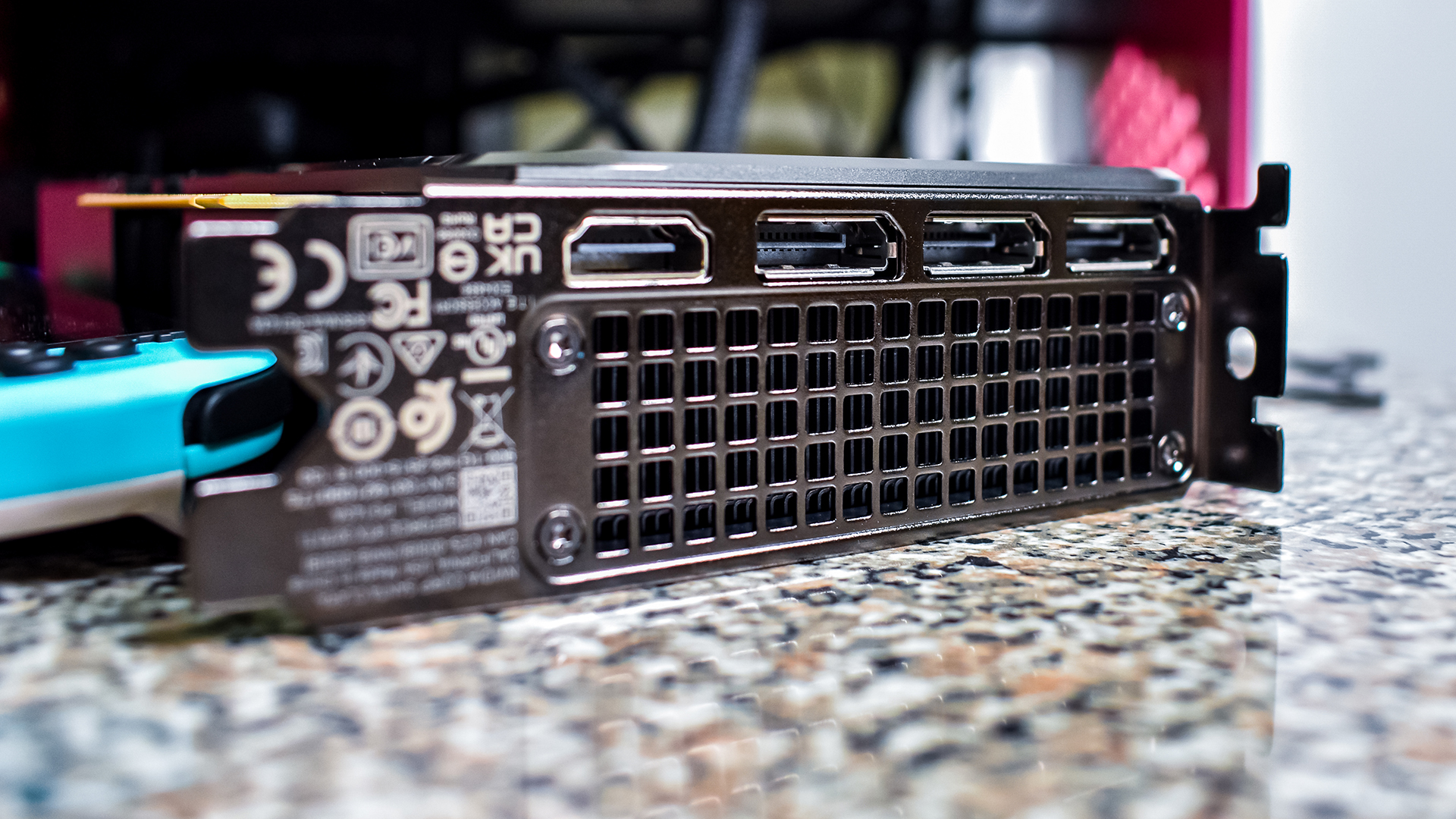
Chipset and features
The Nvidia GeForce RTX 3070 Ti is built on the same Ampere graphics architecture as the rest of the RTX 30 series graphics cards. We've gone in-depth on this architecture in our RTX 3080 review, but we'll give a bit of a refresher here.
With the Ampere graphics architecture, the biggest difference over the last-generation Turing lineup is that Nvidia was able to essentially double FP32 datapaths per Streaming Multiprocessor (SM). That essentially means that while something like the RTX 2070 Super had 2,560 CUDA cores over 40 SMs, an Ampere graphics card with the same amount of SMs would have 5,120 CUDA cores.
When combined with the second-generation RT cores and third-generation Tensor cores, this means the Nvidia GeForce RTX 30-series is a pretty massive improvement over the 20-series.
As for the Nvidia GeForce RTX 3070 Ti itself, you're looking at 48 SMs with a total of 6,144 CUDA cores, 48 RT cores, 96 Tensor cores and 8GB of GDDR6X memory on a 256 bit bus – which is a pretty massive boost over the last-generation RTX 2070 Super. But it's a different story when you look at the RTX 3070.
The original mid-range champion has 46 SMs with 5,888 CUDA cores, alongside 8GB of GDDR6 memory on the same 256-bit bus. So, you're essentially paying an extra $100 – assuming you can buy at MSRP – for 2 extra streaming multiprocessors and faster memory. When we look at the specs on paper, this graphics card would have been much better served as a replacement for the RTX 3070 at around the same price, rather than a significantly more expensive successor.
That slight boost in power also comes with a higher TGP (total graphics power) budget of 290W, which is about where the RTX 3070 Ti peaked in our testing. With a power budget this high, Nvidia is recommending at least a 750W power supply, which is more than the recommended 650W PSU recommended for the vanilla RTX 3070. That means the RTX 3070 is also probably a better pick for folks that are using small form-factor cases.
Unlike the RTX 3070, however, every RTX 3070 Ti will come with Nvidia's LHR (light hash rate) cryptocurrency limiter. This will detect the Ethereum mining algorithm and slow down the graphics card. Ideally, this will stop miners from buying up all the stock, but only time will tell how effective it is.
Of course, because the Nvidia GeForce RTX 3070 Ti is an Ampere GPU, that means you get access to all of Nvidia's juicy software features. RTX Broadcast is a godsend both for streamers and for anyone that has to do a lot of video calls – it filters out background noise from your microphone and headphones, and can even completely replace your background on camera without a green screen. These features work far better than similar solutions built into Zoom or Google Hangouts, too.
And, obviously, you can't talk about the RTX 3070 Ti without talking about, well, RTX. Just like the rest of the cards of this generation, the Nvidia GeForce RTX 3070 Ti has RT cores, with accelerate ray tracing, making games that support it, well, playable. These days, the amount of games that support the technology is growing, thanks in large part to AMD graphics cards also able to power ray-traced workloads.
However, turning on ray tracing is generally a pretty huge performance hit, which means DLSS (Deep Learning Super Sampling) comes in handy to lighten the load a bit. This tech uses AI to upscale your game from a lower resolution to your native resolution, so you can turn on more eye candy without turning your game into a slideshow.
Generally speaking, especially if you plan on pushing the Nvidia GeForce RTX 3070 Ti into 4K, you should enable DLSS whenever it's available. The tech has come quite a long way since it was initially implemented with Shadow of the Tomb Raider and Metro Exodus, and it's basically free performance.

Design
One of the biggest drawbacks to the RTX 3070 and RTX 3060 Ti Founders Editions, when compared to the RTX 3080 and RTX 3090 were the fan configurations. Rather than the unique pass-through design, they resembled a traditional dual-fan design.
This wasn't too big a deal for those cards, mostly due the lower TGP. However, the RTX 3070 Ti gets close to 300W, which means it needs more robust cooling, and Nvidia has provided.
The Nvidia GeForce RTX 3070 Ti Founders Edition looks very similar to the RTX 3080 Ti, only it's a bit shorter, at 10.5 inches to the RTX 3080 Ti's 11.2 inches. That will make it a bit easier to fit into small cases, but it's still a bit bigger than the original RTX 3070, which is 9.5 inches long.
This extra inch allows Nvidia to move one of the fans from the front of the card to the back of the card. This cooling configuration pulls air through the bottom of your case and routes it through your graphics card, shooting the hot air through the top of your case.
It's an extremely effective method of cooling your graphics card, and it meant that even testing it during the middle of a heatwave in New York City, the RTX 3070 Ti peaked at just 82°C. That's a bit higher than the RTX 3080 in the same conditions, but we attribute that to the slightly shorter card.
Like the rest of the Founders Editions this generation, the RTX 3070 Ti is a gorgeous graphics card with a black heatsink, surrounded by a gunmetal gray trim. It looks amazing on our test bench, and we find it hard to imagine any case where it'll look out of place.
But it carries the same issue as the rest of them, too: the power connector. Nvidia is sticking to the 12-pin power connector, and it's something we'll just have to get used to. Luckily, because hardly anyone has a power supply with these power connectors, Nvidia does include a 2 x 8-pin to 1 x 12-pin adapter in the box.
As for ports, you get one HDMI 2.1 and three DisplayPort 1.4, also the same as every other RTX 30-series card. And, we still miss USB-C, and we're going to keep complaining about it until Nvidia brings it back.



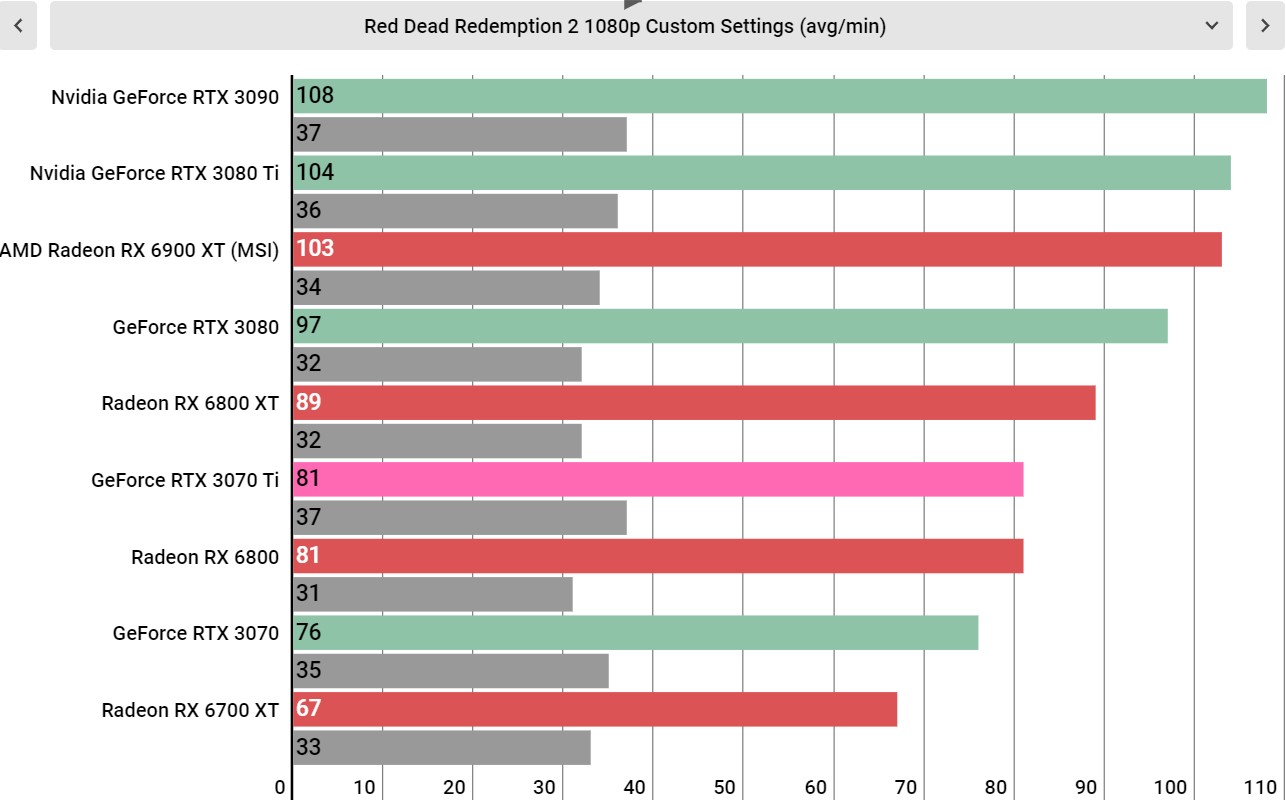







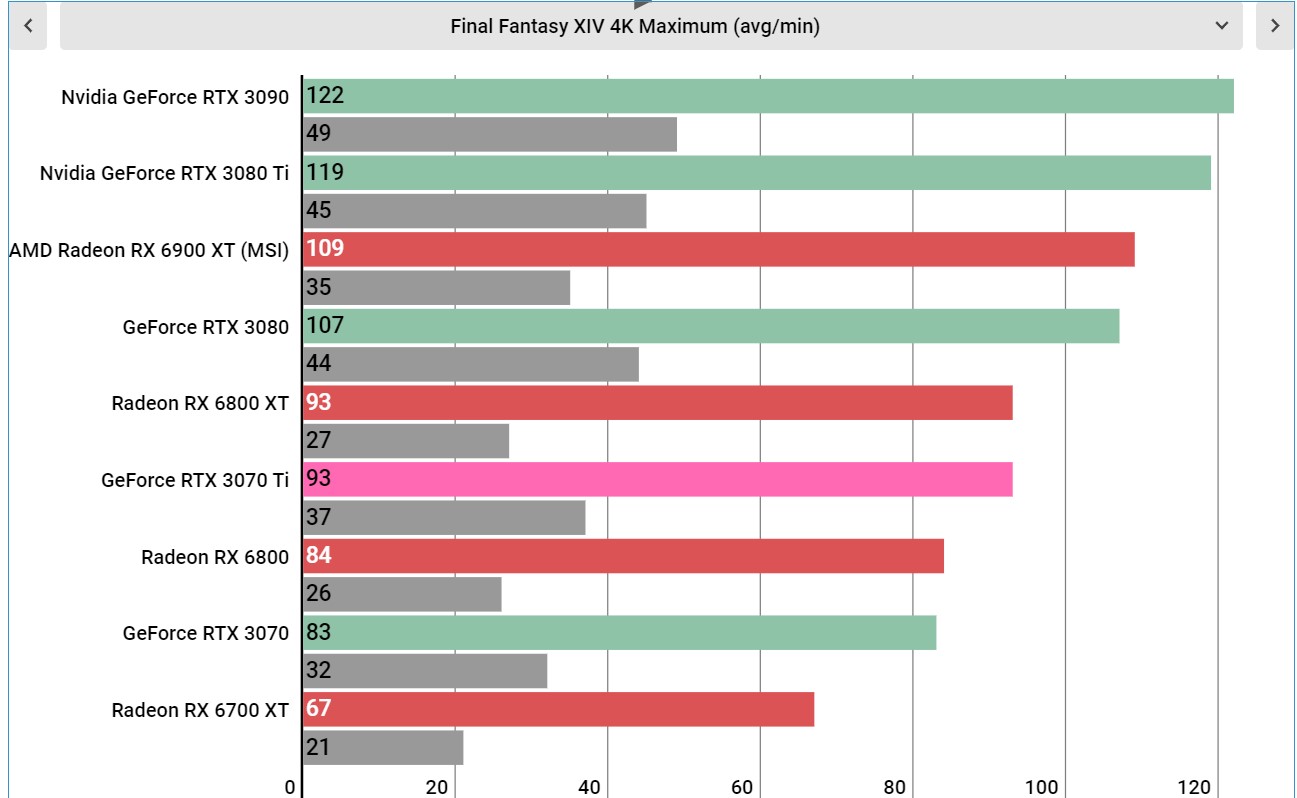

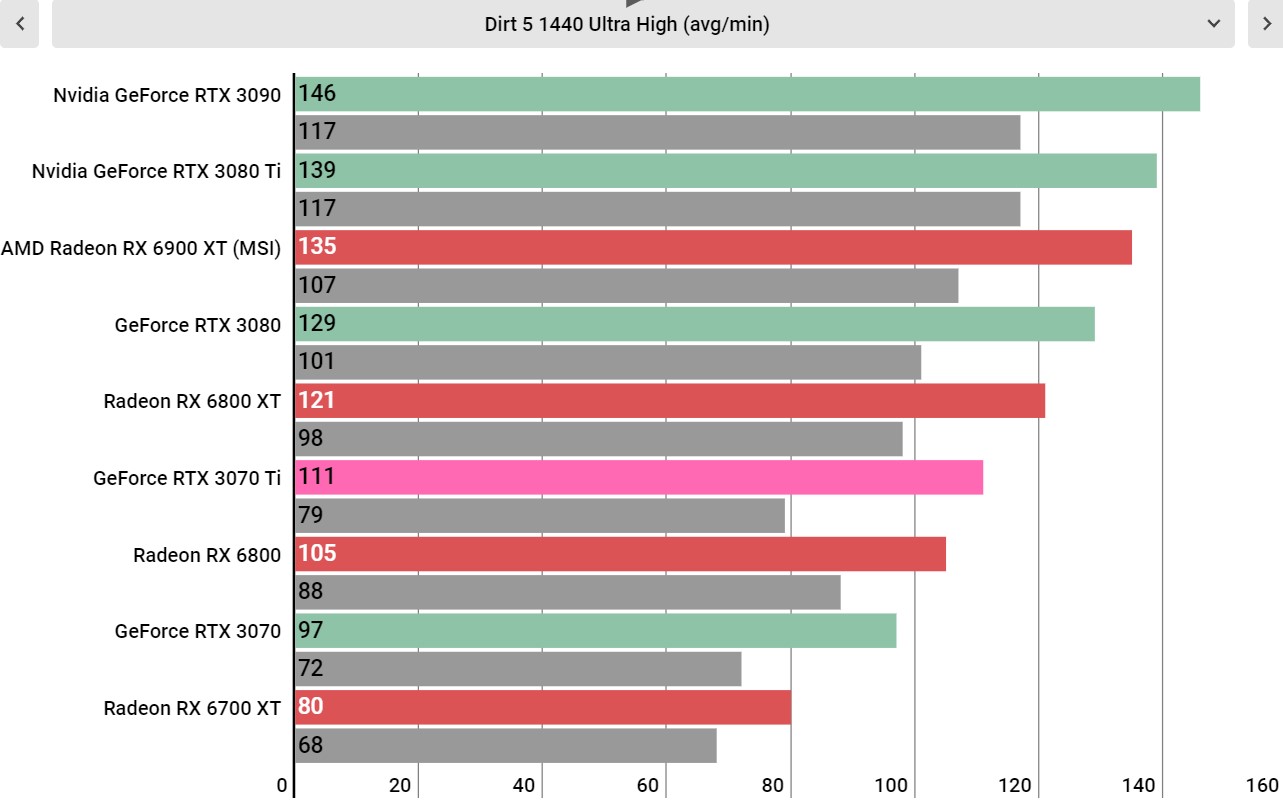



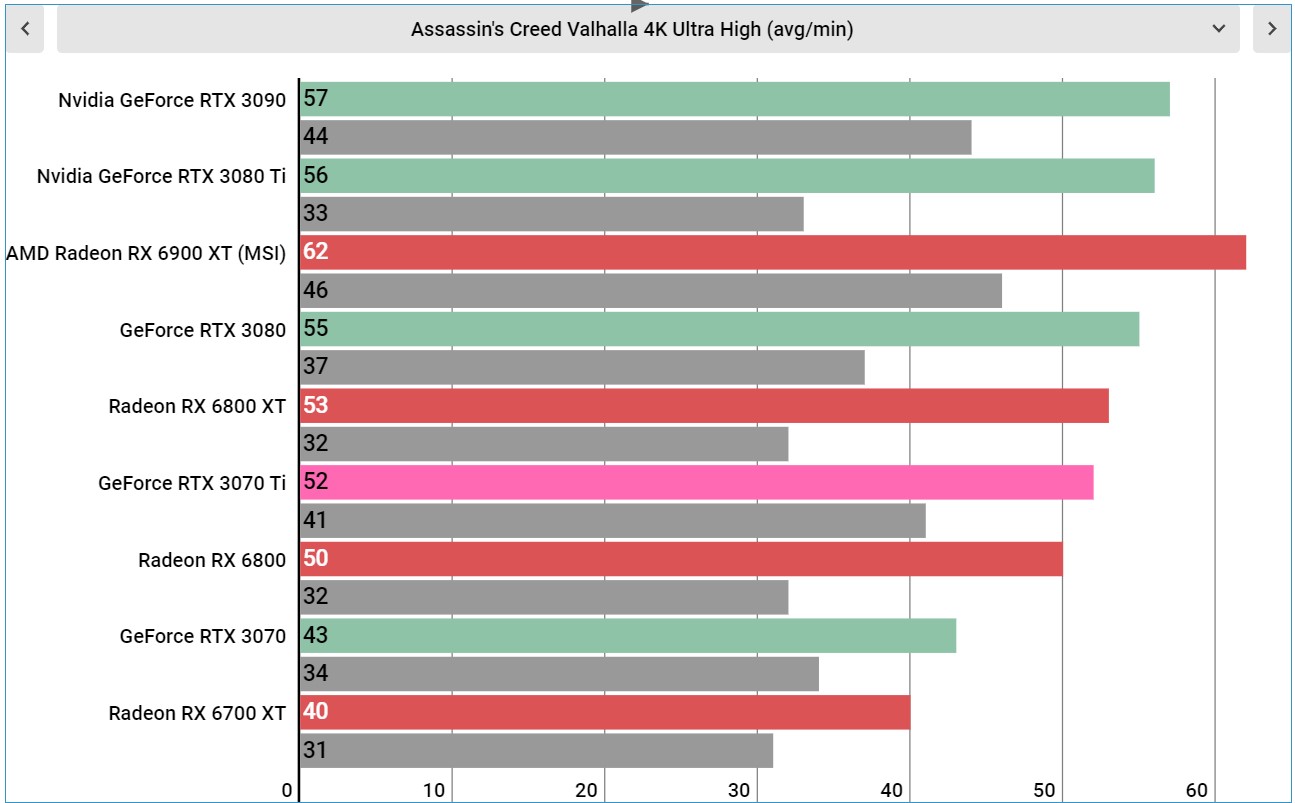








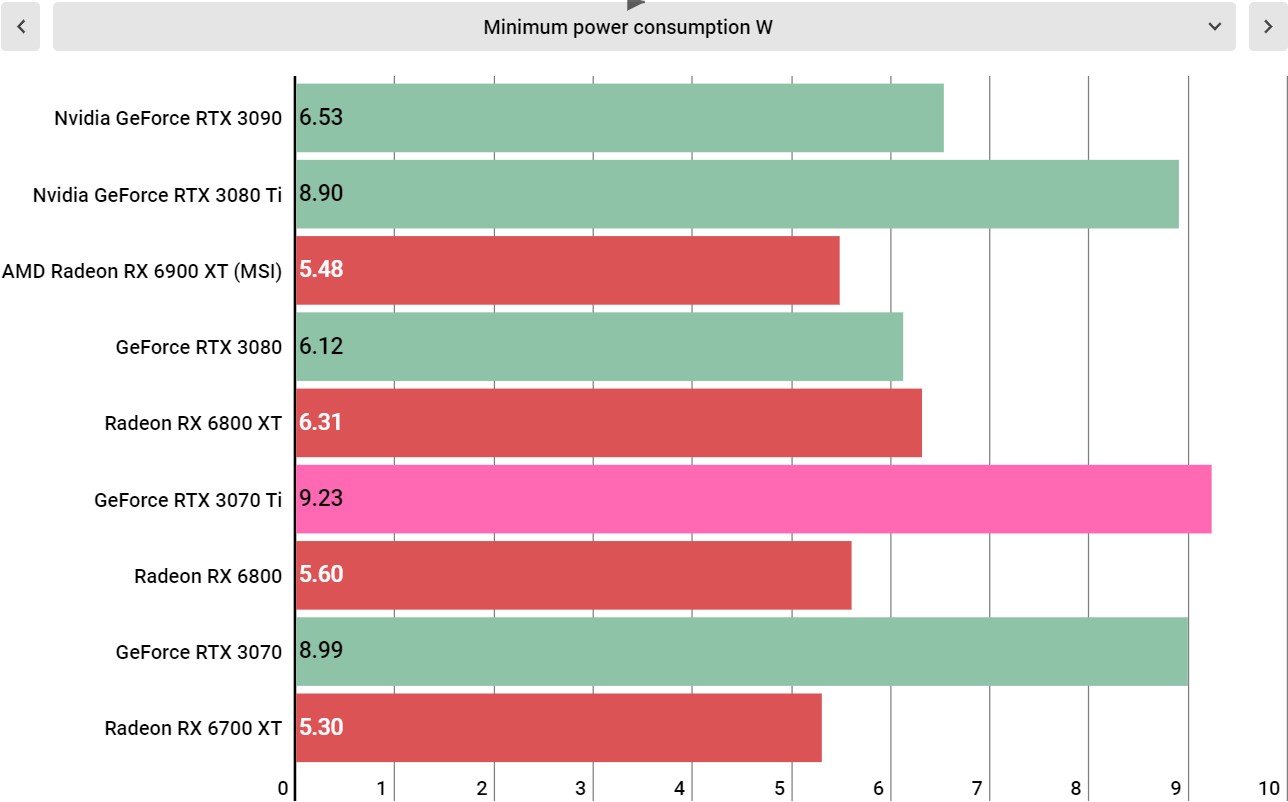

Performance
This is the system we used to test the Nvidia GeForce RTX 3070 Ti Founders Edition:
CPU: Intel Core i9-11900K (8-core, up to 5.3GHz)
CPU Cooler: Cooler Master Masterliquid 360P Silver Edition
RAM: 64GB Corsair Dominator Platinum @ 3,200MHz
Motherboard: MSI MEG Z590 ACE
SSD: ADATA XPG SX8200 Pro @ 1TB
Power Supply: Phanteks RevoltX 1200
Case: Praxis Wetbench
If it existed in a vacuum, the Nvidia GeForce RTX 3070 Ti would be an excellent graphics card. At 1440p, the RTX 3070 Ti is an absolute powerhouse, blowing through every game in our test suite with at least 60, but mostly around 100+ fps. Even in Metro Exodus: Enhanced Edition, without DLSS, the RTX 3070 Ti sat pretty at 66 fps at 1440p - and that's with all the shiny ray-traced effects enabled.
Even at 4K the Nvidia GeForce RTX 3070 Ti is nothing to shake a stick at. In games like Dirt 5, Final Fantasy XIV and Horizon Zero Dawn, the RTX 3070 Ti has no problem at all staying well above 60 fps at max settings, making this an easy choice if you play a lot of MMOs and want to play at 4K.
But the Nvidia GeForce RTX 3070 Ti doesn't exist in a vacuum. At 1440p, the RTX 3070 Ti is faster than the RTX 3070, but not so much that it'll make a huge difference. In Metro Exodus, we're talking the difference between 60 fps and 66 fps. That is a pretty solid 10% jump, but it's not going to exactly be noticeable, and probably isn't worth the 20% price premium you're going to pay.
And while the RTX 3070 Ti can do 4K gaming, and can do it quite well, it doesn't really come close to the RTX 3080. Looking again at Metro Exodus, the RTX 3080 is a whopping 23% faster, and just 16% more expensive. That means that the RTX 3080, even though it's more expensive, is simply a better value.
So while the RTX 3070 Ti definitely works, and provides some excellent gaming performance, we can't really recommend it. And it's not because the RTX 3070 Ti is a bad card, the problem is instead that the other graphics cards out there are so good, that it makes the Nvidia GeForce RTX 3070 Ti completely pointless.
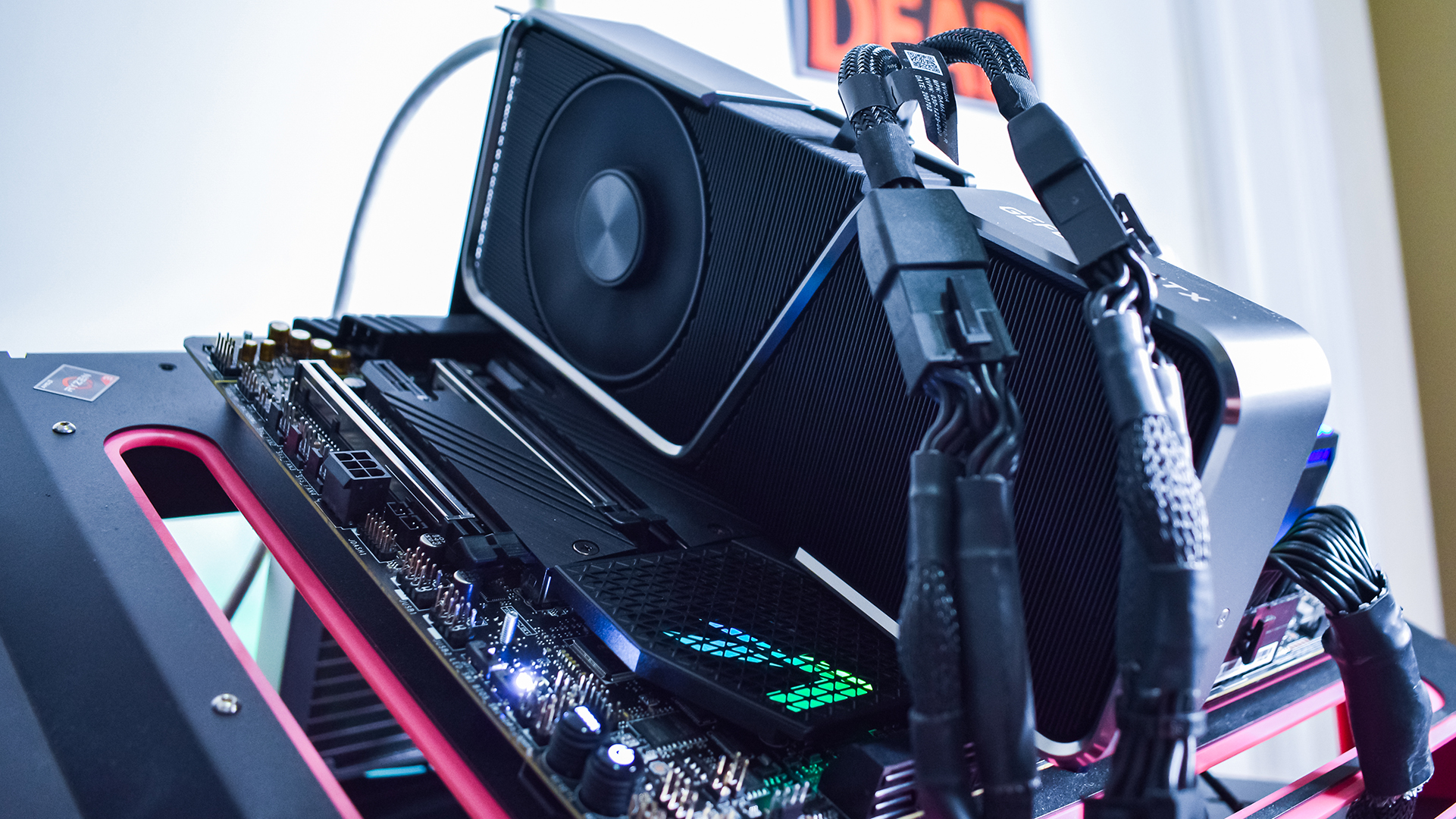
Buy it if...
You just need a graphics card
We get it, it's hard to buy a graphics card. So, if you can find the Nvidia GeForce RTX 3070 Ti around its $599 MSRP, it's probably worth jumping on.
You're playing games at 1440p
The Nvidia GeForce RTX 3070 Ti is probably one of the best graphics cards for 1440p gaming right now.
You want an attractive Founders Edition
Like the rest of the Nvidia GeForce RTX 30-series, the RTX 3070 Ti Founders Edition is a gorgeous piece of hardware that will look good in any case.
Don't buy it if...
You can afford an RTX 3080
The Nvidia GeForce RTX 3080 is just $100 more than the RTX 3070 Ti and provides a huge jump in performance.
You can find an RTX 3070
While the Nvidia GeForce RTX 3070 Ti is faster than the original RTX 3070, it's not enough of a performance boost to be worth the higher price tag.
You have less than a 750W PSU
In the past a lot of mid-range cards like the GTX 1070 Ti and RTX 2070 Super only needed a 550W PSU, so you may need to upgrade your power supply for the RTX 3070 Ti, which is quite a chore.

Jackie Thomas is the Hardware and Buying Guides Editor at IGN. Previously, she was TechRadar's US computing editor. She is fat, queer and extremely online. Computers are the devil, but she just happens to be a satanist. If you need to know anything about computing components, PC gaming or the best laptop on the market, don't be afraid to drop her a line on Twitter or through email.
